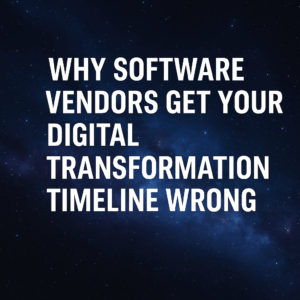Author: Eric Kimberling
Navigating the complexities of implementation phasing in an organization can be an intricate art interwoven with a defined science. It’s a balancing act of strategic planning, organizational understanding, and risk management.
This blog aims to demystify the art and provide insights into the science behind effective implementation phasing.

Table of Contents
ToggleUnderstanding Implementation Phasing
At its core, implementation phasing is about deploying new technology or strategies in stages. There are two primary approaches: the ‘big bang’ method, where everything is deployed simultaneously, and the incremental approach, which involves a phased rollout. Most organizations opt for the latter, especially those averse to high risks. However, the challenge lies in determining the right phases and the specifics of each phase for your organization.
Why is Implementation Phasing Effective?
Implementation phasing is effective for several key reasons, each contributing to a more controlled, adaptable, and ultimately successful project rollout. Here’s why:
- Risk Mitigation: Phasing breaks down a large project into manageable parts, reducing the risks associated with implementing a complex system all at once. If issues arise, they’re typically smaller in scale and can be addressed more easily without affecting the entire system.
- Enhanced Focus and Quality Control: By focusing on one phase at a time, teams can effectively concentrate their efforts and expertise. This focused approach often leads to better quality work, as resources aren’t spread too thin across multiple areas simultaneously.
- Improved Change Management: Gradual implementation allows employees to adjust to new systems and processes in stages, reducing resistance and stress. This phased approach facilitates better training and support, ensuring that each new system or process is adequately understood and adopted before moving on to the next.
- Feedback Integration: After each phase, feedback can be gathered and analyzed to make improvements in subsequent phases. This continuous feedback loop and enhancement helps fine-tune the system to better meet the organization’s needs.
- Budget Management: Phased implementation allows for more predictable and spread-out expenditure. Tracking and controlling costs for smaller project segments is easier than a large-scale implementation. Additionally, if budget constraints arise, later phases can be adjusted or postponed without jeopardizing the entire project.
- Adaptability: In a rapidly changing business environment, phased implementation makes organizations more agile. If external conditions or internal priorities change, future phases can be adjusted accordingly without overhauling an entire system.
- Increased Success Rates: The likelihood of successful implementation increases by managing smaller, more manageable project parts. Each phase can act as a stepping stone, building confidence and proving the project’s value as it progresses.
- Resource Optimization: Resources, including personnel and technological assets, can be allocated more efficiently in a phased approach. Teams are not overwhelmed with an all-at-once implementation, leading to better utilization of human and technical resources.
- Strategic Alignment: Phasing allows for alignment with broader organizational strategies and goals. Each phase can be strategically timed and aligned with other business initiatives for maximum impact.
- Stakeholder Engagement and Support: Incremental successes of each phase can foster stakeholder engagement and support, which is crucial for long-term project viability. Demonstrating progress and benefits, stage by stage helps maintain enthusiasm and backing from key stakeholders.
Implementation phasing offers a more controlled, focused, and adaptable approach to complex projects. It aligns with human and organizational capacities for change, making it a highly effective strategy in diverse organizational contexts.

How to Plan Implementation Phasing?
Business Processes as a Phasing Criterion
One effective way to phase your technology implementation is by focusing on business processes that add the most value. If enhancing top-line revenue growth is a priority, automating sales processes could be your first phase. This method involves identifying areas of immediate potential value and aligning your phasing strategy accordingly.

Software Modules and Integration
The architecture of your chosen software solution plays a crucial role in determining your phasing strategy. Understanding how different software modules interact and depend on each other is crucial. For example, it might be impractical to deploy financial reporting without implementing inventory management due to their interdependent nature.
Organizational Considerations in Phasing
Understanding your organization’s culture, pain points, and readiness for change is crucial. Prioritize areas of your organization that need improvement and are most receptive to new technologies. This approach brings immediate benefits and builds momentum and acceptance for subsequent phases.
Risk Management in Implementation Phasing
Your organization’s risk tolerance should significantly influence your phasing strategy. More risk-averse organizations might prefer a slower, incremental rollout with multiple phases. This approach necessitates careful management of risks like change fatigue and interim integration challenges.

Scope Management
Sometimes, the most effective strategy is to scale back the project scope. Focusing on deploying fewer technologies with greater efficiency can reduce risks and costs while ensuring significant short-term value.
Conclusion
Determining the ideal implementation phasing strategy involves reconciling various factors: business processes, software architecture, organizational culture, risk management, and project scope. There’s no one-size-fits-all solution; it’s about finding the balance that aligns with your organization’s needs and capabilities.
To dive deeper into digital strategies and implementation phasing, consider reading my new book, “The Final Countdown,” available on Amazon. This resource offers more detailed insights into crafting an implementation strategy tailored to your organization’s unique landscape.
As we navigate the path of digital transformation and technological implementation, it’s crucial to remember that each organization’s journey is unique. By understanding the interplay of various factors in implementation phasing, you can tailor a strategy that maximizes benefits while mitigating risks, ultimately leading to a successful and sustainable transformation.
I hope you found this information helpful. For more insights and assistance in navigating your ERP journey, don’t hesitate to get in touch with me at Eric.Kimberling@Thirdstage-consulting.com or explore our resources at Third Stage Consulting. I am happy to be an informal sounding board for your transformation journey.
I also highly recommend downloading our 2024 Digital Enterprise Operations Report and following our weekly podcasts or YouTube channel for more on the holistic approach to business technology.





